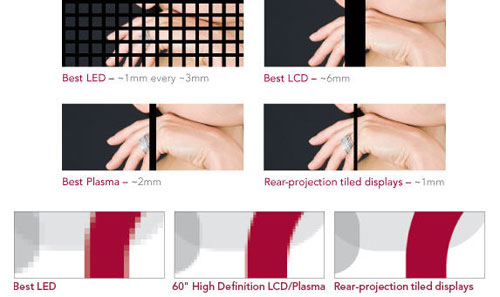Rear-Projection Tiled Digital Media Walls
Conclusion
Rear-projection, modular video building blocks can be used to create rich media displays for almost any orientation, size or shape to complement architectural design elements. The combination of DLP® and LED technology provides ultra-sharp, high-contrast images, and a richly saturated, vibrant color spectrum. This rear-projection digital display wall technology is suitable for a variety of building types and applications, and capable of showing dynamic messages, static images and several videos on a single display. Ease of maintenance and operation, longevity of parts, low energy consumption, and low life-cycle costs make rear-projection tiled digital media walls an ideal design solution for communicating information or creating eye-catching visuals in any public space.
 |
Comparison of seam widths and resolution for various digital media wall technologies. Image by Christie |
Glossary
Candela
A candela is a standard international unit of luminous intensity, a power emitted by a light source in a particular direction.
Color space
A term describing an abstract model of how colors are represented in a triangle where each point is red, blue, and green. The color mixing within a digital color display is the color space.
Digital Light Processing DLP®
DLP® technology is an intelligent display technology that is used in a variety of display applications. It can be found in DLP® front projectors as well as rear-projection television sets and digital signage. It is also the leading technology used in digital cinema projection.
DLP® is reflective. Light is reflected off tiny, hinged mirrors called Digital Micro-Mirror Devices (DMDs). Each DMD reflects a single pixel in the resolution of the projected image and each DMD can be controlled separately. The space between each DMD is much smaller than with other technologies. These DMDs create an image with superior color fidelity that’s smooth and clear.
DLP® projectors are brighter than other technologies. Almost all of the light is reflected out of the projector, making DLP® projectors brighter than other technologies that tend to absorb light. The result is small DLP® projectors that can produce higher brightness using less power than much larger projectors that use other technologies.
Helmholtz-Kohlrausch (HK) Effect
A scientific phenomenon whereby the human eye can perceive reds and blues to be richer and deeper and yellows brighter than they may actually be just by the way the colors are reproduced. The more saturated the colors are, the greater the HK Effect. In more scientific terms, this is a phenomenon where the intense saturation of spectral hue is perceived as part of the color’s luminance. This brightness increase by saturation grows stronger as saturation increases.
Liquid Crystal Display (LCD)
A liquid crystal display (LCD) is a flat-panel display, electronic visual display, or video display that uses the light modulating properties of liquid crystals (LCs).
Light Emitting Diodes (LEDs)
An LED is a semiconductor light source. LEDs are often small in area (less than one sq. mm). LEDs have allowed new text, video displays and sensors to be developed. LEDs are used in applications as diverse as aviation lighting, automotive lighting, advertising, general lighting, and traffic signals.
Nit
In lighting, the nit is a unit of visible-light intensity, commonly used to specify the brightness of a digital display.
Pixel
In digital imaging, a pixel is a physical point in a raster image, or the smallest addressable element in a display device. A pixel is the smallest controllable element of a picture represented on the screen.
Pixel pitch (or dot pitch)
Pixel pitch or dot pitch is a specification for a computer display, computer printer, image scanner, or other pixel-based device that describes the distance between dots (sub-pixels) of the same color on the inside of a display screen. In the case of a color display, pixel pitch is a measure of the size of a triad plus the distance between the triads.
Pixel pitch may be measured in linear units, usually millimeters, or as a rate, for example pixel per inch, with a larger number meaning higher resolution. Closer spacing generally produces a sharper image, as there are more pixels in a given area.
Raster
A scanning pattern of parallel lines that form the display of an image projected on a cathode-ray tube of a television set or display screen.
 |
Christie® is a global visual technologies company. Using DLP®, LCD and LED technologies, Christie’s broad range of visual solutions include: media walls, digital cinema projectors, networking solutions, and cutting-edge 3D virtual reality and simulation projection systems. www.microtiles.com |








